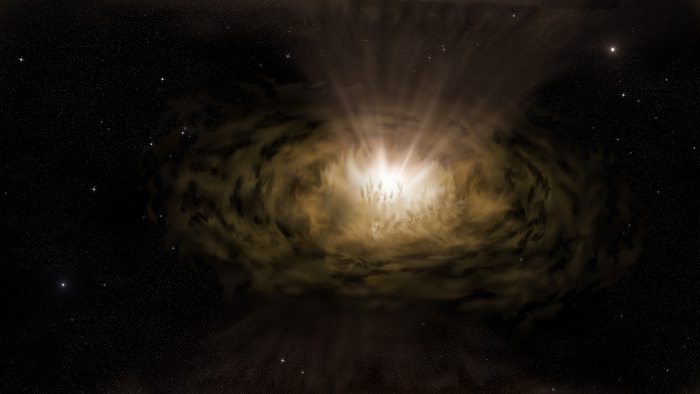Active galactic nuclei are known to be the strongest compact steady sources of energy in the universe.

An artist’s impression of what the dust around an active galactic nucleus might look like seen from a light year away. Image Credit: Peter Z. Harrington
The existence of the brightest active galactic nuclei has long been known to far outshine the integrated light of the billions of stars present in their host galaxies.
A new study performed shows that researchers have considerably undervalued the energy output of such objects by not acknowledging the extent to which their light has been dimmed by dust.
When there are intervening small particles along our line of sight, this makes things behind them look dimmer. We see this at sunset on any clear day when the sun looks fainter.
Martin Gaskell, Research Associate, Astronomy and Astrophysics, University of California-Santa Cruz
Gaskell is the lead author of a study on the new findings reported in the Monthly Notices of the Royal Astronomical Society on January 16th, 2022.
Although the chances of dust dimming the light from active galactic nuclei have been identified for a while, the amount has been debated and was frequently believed to be negligible, stated Gaskell.
“We have shown that this is not the case and that the far ultraviolet light of a typical active galactic nucleus is dimmed by a large factor,” Gaskell said.
This conclusion was reached by the group by studying the reddening effect of dust on the light coming from one of the most well-studied active galactic nuclei, called NGC 5548. Similar to how the Earth’s atmosphere makes the sun emerge redder as well as dimmer at sunset, in the same way, the dust present in the active galactic nuclei also makes them appear redder than they really are. The amount of reddening corresponds to the amount of dimming.
Researchers measure the colors of something by quantifying the ratios of the intensity of its light at various wavelengths. While we know what a non-reddened sun looks like, there has been much discussion over the non-reddened emissions coming from active galactic nuclei.
In the new study of NGC 5548, the University of California-Santa Cruz (UCSC) scientists made use of seven indicators of the amount of dust and discovered them all to be in reasonable agreement. Moreover, the NGC 5548’s dimming as a result of dust was shown to be large, over ten times the dimming caused by dust seen in the Milky Way.
The good agreement between the different indicators of the amount of reddening was a pleasant surprise. It strongly supports simple theories of emission from active galactic nuclei. Exotic explanations of colors are not needed. This makes life simpler for researchers and is speeding up our understanding of what happens as black holes swallow material.
Martin Gaskell, Research Associate, Astronomy and Astrophysics, University of California-Santa Cruz
The NGC 5548’s colors are normal for other active galactic nuclei, stated Gaskell, which has extensive implications.
The outcomes suggest that in the ultraviolet, where the majority of the energy has been radiated, a normal active galactic nucleus is putting out an order of magnitude more energy compared to what was previously thought, stated Gaskell.
Gaskell stated that one more implication is that active galactic nuclei are extremely similar, and what have so far been thought to be significant fundamental variations between them are really just the impacts of various amounts of reddening dust.
The co-authors of the Gaskell—Frances Anderson (now at Harvey Mudd College), Sufia Birmingham (now at Princeton University), and Samhita Ghosh (currently at UC Berkeley)—worked on this project.
Journal Reference
Gaskell, C. M., et al. (2022) Estimating reddening of the continuum and broad-line region of active galactic nuclei: the mean reddening of NGC 5548 and the size of the accretion disc Get access Arrow. Monthly Notices of the Royal Astronomical Society. doi.org/10.1093/mnras/stac3333.